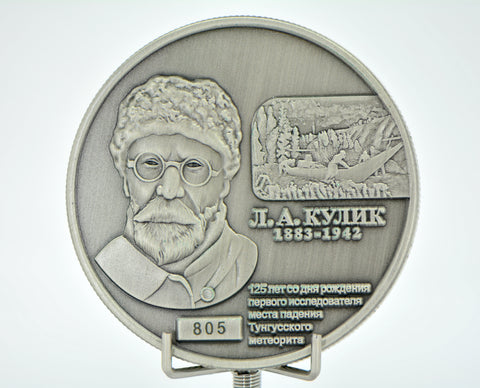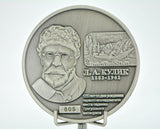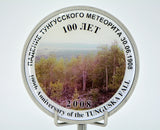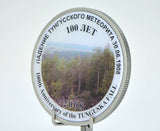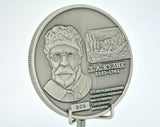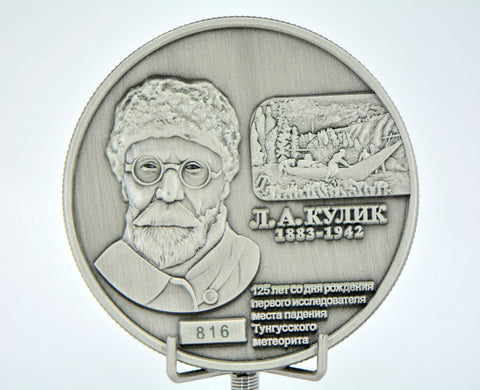Tunguska Meteorite Observed Fall 100th Anniversary Coin No. 805 - 1908 Russia
On Offer: Conmemorative coin of the 100th Anniversary Tunguska meteorite observed fall on June 30, 1908
Limited Edition: Coin No. 805 of 1000 total commemorative coins made.
Diameter Size: 51mm
Coin Thickness: 4mm
In the summer of 1957, while studying simples of soil brought by L.A. Kulik's expeditions in the years 1929-1930 from the place of the Tunguska Meteorite (U.S.S.R.) fall, A. A. Yavnel', of the Committee on Meteorites, U.S.S.R.. Academy of Sciences, discovered particles of meteoritic and meteoric dust.
The particles of the meteoritic dust are small laminae with sharp corners, chips or pieces measuring a fraction of a millimeter or more, and are the result of the crushing of the meteorite during its fall (explosion). Spectrographic and microchemical analyses showed iron with 7 to 10 per cent nickle content and approximately 0.7 per cent cobalt. The composition and presence of some dust particles clearly shaped as little columns prompt the suppostition that the Tunguska meteorite is of the iron, oetahedrite class.
The particles of dust are regular black globules (probably magnetite) 0.03 to 0.06 mm in diameter. So far only nine globeles have been discovered and since there are very few of them, analyses have not been made. The globules are the result of melting of meteoritic matter during passage through the earth's atmosphere, and were part of the smoke-train of fire-ball that settled on the earth's surface and became mixed with the soil.
What you get: Tunguska witnessed fall commemorative coin as shown.
SEE OFFICIAL METEORITICAL SOCIETY ENTRY BELOW
| Tunguska | |||||||||||||||||
|---|---|---|---|---|---|---|---|---|---|---|---|---|---|---|---|---|---|
| Basic information |
Name: Tunguska This is NOT an official name: Doubtful meteorite. Abbreviation: There is no official abbreviation for this meteorite. Observed fall: Yes Year fell: 1908 Country: Russia Mass:  13.4 g 13.4 g |
||||||||||||||||
| Classification history: |
|
||||||||||||||||
We Also Recommend

